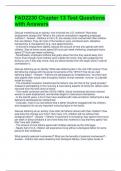FAD2230 Chapter 13 Test Questions
with Answers
Discuss mothering as an activity: how involved are U.S. mothers? How does
employment change this? What is the cultural contradiction regarding employed
mothers? - Answer-- Mothers in the U.S. are usually more involved with their children
than are fathers. They do most of the hands-on care, emotional work, discipline,
transporting, & management (e.g. care appointments).
- A woman's employment slightly reduces the amount of time she spends with their
children. Stay at home moms spend 32 hours per week mothering; employed moms
spend 27 hours per week mothering.
- Nonetheless, employed mothers feel guilty about the time they spend away from
home. Even though most mothers work outside the home, they face judgement for
doing so; yet, if they stay home, they are disconnected from the larger world (*cultural
contradiction*).
Discuss fathering as an identity: What was fathering like in the mid-19th century? How
did fathering change with the social movements of the 1970's? How do we view
fathering today? - Answer-- Fathers are stereotyped as "breadwinners," but they have
also played other social roles throughout history (moral overseer, nurturer, & a gender
model for sons).
- The industrial revolution transformed the father's role into that of the "good provider".
Instead of participating in the nurturing & care-taking aspects of family life, fathers were
removed from the work done at home.
- This model continued until the 1970's-1980's. Social movements led more married
women to seek employment, and families began to restructure themselves.
- In the last 20 years, a lot of men have wrestled with roles as fathers; fatherhood is less
defined & stereotyped as motherhood.
- Culturally, most of us now believe that a father should be engaged with his children,
and recognize him as any important nurturing figure in the family.
Discuss fathering as an activity: How often do fathers interact with their children? How
was does this change over time? How many U.S. children will live without their
biological father? - Answer-- Fathers' involvement is increasing; they spend more hours
per week in direct childcare & are more likely than mothers to say that they spend "too
little" time with children.
- The amount of time fathers spend with children declines as the child ages.
- Nearly half of U.S. children will experience living without a biological father for some
period of their childhood.
What predicts paternal involvement? What are the benefits of paternal involvement? -
Answer-- Fathers who were raised by their biological fathers, have higher levels of
, education, have employed partners, & have more egalitarian views about gender, are
more involved with their children.
- Father's involvement can enhance children's social, emotional, & cognitive wellbeing.
The degree of "father love" (children's perceptions of paternal acceptance/rejection &
affection/indifference) is just as important in the lives of children as "mother love".
What is the *bi-directional nature of parenting*?How does *systems theory* explain the
exchange between parents & children? What factors do children influence their
socialization through? - Answer-- The *bi-directional nature of parenting* explains how
parents influence their children, and children also influence their parents.
- *Systems theory* reminds us that families aren't just one unit. They are made up of
many difference subsystems, and each subsystem operates to influence the whole.
- Parents don't simply socialize children; children influence their socialization through
*temperament*, *cognitive abilities*, *health & well-being*, and *sex*.
How does "good parenting" differ among cultures? - Answer-- How we parent our
children and what we consider good parenting differs among cultures.
- For example, in some cultures, parents "wear" their children, sleep with their children,
breastfeed their children for several years, and are rarely separated; whereas in
America, our babies sleep in separate rooms, are fed by bottles, & are carried in
strollers.
- In many places without access to birth control (such as Africa), families commonly
have 6-8 children
- Across all cultures, parents' primary job is *socialization*.
How do maternity & paternity benefits differ among nations? - Answer-- In other
countries, parents have an extensive array of maternity & paternity benefits that allow
them to stay at home while their children are young without losing jobs, seniority or pay.
- In many European countries, families receive a cash benefit from the government to
help with the costs of raising children called a *family allowance (child allowance)*. It is
available to all families, rich or poor.
- In the U.S., there is no mandated paid maternity leave, and women return to work very
quickly.
What was parenting like in colonial America? How did parenting change during
industrialization, urbanization, immigration? How did parenting change in the
progressive era of the 1900's? - Answer-- What we consider good parenting today was
not always seen that way. In colonial America, parents were strict and emotionally
distant; children were thought to have "original sin". They were treated like miniature
adults and put to work to help support the family.
- Industrialization, urbanization, and immigration brought change. Produced two views
of childhood: the *protected child* among wealthy families, who was given education &
leisure; and the *useful child* among poor families, whose labor was needed to make
ends meet.




